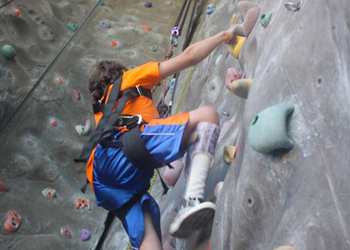Written by Vapur Pro Team member, Laura Bylund.
Cottage Rehabilitation Hospital, UCSB Department of Recreation and Vapur, July 22-26, 2013Every summer, about 45 children and teens with disabling diseases, disorders and spinal cord injuries come from far and wide to the UCSB Recreation Center for a week of intense sporting organized by Santa Barbara Cottage Rehabilitation Hospital. They play basketball and volleyball, racquetball and rugby. They go swimming and handcycling, and have tennis lessons with three-time Paralympian, Anthony Lara. They also engage in adventure activities such as kayaking, ropes course, SCUBA and, of course, what kind of sports camp would be complete without rock climbing?Real interest in adaptive climbing has been sparked among many wheelchair users across the globe. Perhaps it is the sport of rock climbing becoming more mainstream, or maybe inspiration from famous disabled athletes such as blind mountaineer, Erik Weihenmayer, incomplete tetraplegic competition climber, Fran Brown and the more recent scaling of El Capitan by Stephen Wampler, who has cerebral palsy. Either way, despite the growing interest, working with people with disabilities is still a very complex and out of the ordinary thing for most vertical sports professionals and high angle rope workers.The Junior Wheelchair Sports Camp has both excited and panicked me for nearly a decade. Beyond the usual concerns that come with any children's program, including the naturally worrisome parents and doting caretakers, each year purports a completely new test for me and my staff. The kids come to us both excited and terrified themselves, and we are responsible for the quality of their experience.As vertical world risk managers, harnessing and handling these courageous 6 to 19 year-olds is some of the most challenging work we do. Helping them get to the top isn't the hard part; we have strong arms and mechanical advantage to thank for that. It is more the meticulous setup and unconventional hard and soft skills that go with it.We rely on camp staff and volunteers to ask the right questions and transfer the person when necessary for outfitting. Even in my 9th year, I still feel uncomfortable asking whether a camper can support him/herself while we slip the harness on. And while those aforementioned inspirational climbers have painstakingly whittled their systems down to a science, we are given but minutes to determine a specialized setup for each child."You're pretty buff, right?" I ask a camper named Alex from one of the younger groups. This is my standard question for those with high functioning upper bodies. "Yesss!" he replied in a deep voice, flexing his biceps, fists clenched overhead with a bodybuilder grunt.








